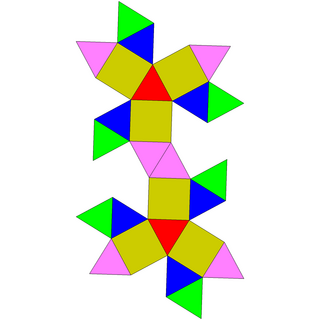Gyroelongated triangular bicupola
| Gyroelongated triangular bicupola | |
|---|---|
 | |
| Type | Johnson J43 – J44 – J45 |
| Faces | 2+3×6 triangles 6 squares |
| Edges | 42 |
| Vertices | 18 |
| Vertex configuration | 6(3.4.3.4) 2.6(34.4) |
| Symmetry group | D3 |
| Dual polyhedron | - |
| Properties | convex, chiral |
| Net | |
 | |
In geometry, the gyroelongated triangular bicupola is one of the Johnson solids (J44). As the name suggests, it can be constructed by gyroelongating a triangular bicupola (either triangular orthobicupola, J27, or the cuboctahedron) by inserting a hexagonal antiprism between its congruent halves.
A Johnson solid is one of 92 strictly convex polyhedra that is composed of regular polygon faces but are not uniform polyhedra (that is, they are not Platonic solids, Archimedean solids, prisms, or antiprisms). They were named by Norman Johnson, who first listed these polyhedra in 1966.[1]
The gyroelongated triangular bicupola is one of five Johnson solids which are chiral, meaning that they have a "left-handed" and a "right-handed" form. In the illustration to the right, each square face on the bottom half of the figure is connected by a path of two triangular faces to a square face above it and to the right. In the figure of opposite chirality (the mirror image of the illustrated figure), each bottom square would be connected to a square face above it and to the left. The two chiral forms of J44 are not considered different Johnson solids.
Formulae
The following formulae for volume and surface area can be used if all faces are regular, with edge length a:[2]
- [math]\displaystyle{ V= \sqrt{2} \left(\frac{5}{3}+\sqrt{1+\sqrt{3}}\right) a^3 \approx 4.69456...a^3 }[/math]
- [math]\displaystyle{ A=\left(6+5\sqrt{3}\right)a^2 \approx 14.6603...a^2 }[/math]
References
- ↑ Johnson, Norman W. (1966), "Convex polyhedra with regular faces", Canadian Journal of Mathematics 18: 169–200, doi:10.4153/cjm-1966-021-8.
- ↑ Stephen Wolfram, "Gyroelongated triangular bicupola" from Wolfram Alpha. Retrieved July 30, 2010.
External links
 |

